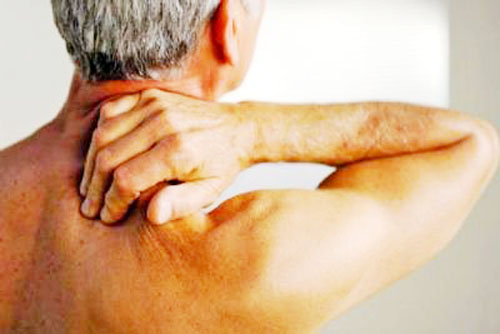Dr. Amresh Jamwal
Cervical spondylosis is a degenerative disease of the cervical spine characterized by decrease in joint space of cervical spine. The cervical spines consist of 7 vertebrae. Prolonged degeneration of the cervical spine results in narrowing of the spaces between the vertebrae. It is accompanied by pain and stiffness of the neck. X-ray images show decreased joint space of cervical discs and formation of Osteophytes (bony spurs). Due to the facet joint degeneration in cervical spondylosis, the effected joints will have a loss of normal range of movement. This results in other levels having to compensate, leading to loss of mobility. When there is a significant loss of mobility, general range of motion will be limited and patients often complain of pain in the neck and referred pain to the shoulder or arm.
Symptoms can range from mild to severe. Symptoms may include:
* Pain in the neck: This may spread to the shoulders and base of the skull. Movement of the neck may make the pain worse. The pain sometimes spreads down an arm to a hand or fingers. This is caused by irritation of a nerve which goes to the arm from the spinal cord in the neck. The pain tends to come and go with flare-ups from time to time. Patient may have a flare-up of pain after unaccustomed use of neck, or if he sprains a neck muscle or ligament. However, a flare-up often develops for no apparent reason. Some people develop chronic (persistent) pain.
* Some neck stiffness, particularly after getting up in the morning.
* Headaches may occur: The headaches often start at the back of the head just above the neck and travel over the top to the forehead. It has been found that 14-18% of chronic headaches are cervicogenic, i.e. headaches which result from musculoskeletal dysfunction in the cervical spine. Hence it is important to assess and treat the upper cervical spine in patients with cervicogenic headache.
* Raising the affected arm above the head reduces pain (Shoulder abduction test)
* Lhermitte’s sign. It is defined as a sudden electrical sensation down the neck and back upon flexing (forward bending) the neck.
* Development of ‘pins and needles’ in part of an arm or hand. This symptom is caused by irritation of a spinal nerve as it leaves the vertebral area. Consult your doctor if loss of feeling (numbness) or weakness develops in a part of a hand or arm. These symptoms suggest more pressure on a nerve. This is called a Cervical radiculopathy.
* More rarely, clumsiness of a hand, problems with walking, or problems with bladder function occur when pressure from a worn vertebra or disc damages the spinal cord. This is called Cervical myelopathy. It is important to report these symptoms to a Doctor
Treatment:
Treatment can be classified into two types- Non operative and Operative.
Non operative treatment:
Non operative treatment provides good to excellent results in around 75% of cases of Cervical spondylosis with good long term results. Non operative treatment consists of pain killers, non steroidal anti inflammatory drugs (NSAIDs), muscle relaxants and physiotherapy.
Physiotherapy treatment:
In patients with Cervical spondylosis the basic assessment starts with a posture check and then focuses specifically in identifying and treating which joints and muscles are affected. Often, patients with Cervical spondylosis present with a forward head posture, and/ or flat lower back. This posture will put the cervical joints in constant compression, leading to joint degeneration at those levels. Unless the compression on cervical spine is relieved through thoracic spine extension and upper cervical retraction any treatment will be of short term benefit. Physiotherapy treatment is recommended to reduce pain, restore range of motion and function, and to strengthen and stabilize the spine. Physiotherapy includes:
* Bracing, strengthening and stretching exercise and activity modification.
* Cervical traction for normalizing disc space.
* Ultrasound and TENS for control of pain.
* Applying either ice or a heating pad to the neck for reducing the pain. Alternate cold and hot therapy is more effective than using either one.
* Loss of mobility is treated with mobilization and self mobilization techniques. This is done through reducing spasm and lengthening the effected muscles. A technique that is often used to achieve this is Muscle energy technique. Muscle energy technique promotes muscle relaxation. This technique involves sub maximal contraction of the effected muscle and on releasing this contraction, this muscle is stretched to a new length. This is a more effective technique than plain stretching because of the specificity of the level.
* A Physiotherapist will give specific neck exercises for the patient to do as a part of home exercise regime.
Operative treatment:
Operative treatment is considered in cases which do not respond to non operative treatment. The surgical procedure preferred is removing the bone spur and possible fusion of two or more cervical vertebrae.
Some useful tips:
* A good posture may help. Check that your sitting position at work or at the computer is not poor (that is, not with your head bent forward with a stooped back).
* Sit upright to improve posture.
* A firm supporting pillow seems to help some people when sleeping. Try not to use more than one pillow.
* Wear a neck brace or a cervical collar at regular intervals during the day to keep a check on neck motion. This is turn will reduce the irritation in the nerves.
* Yoga is helpful. There are certain yoga poses and postures that can help strengthen the back muscles, which in turn increase their flexibility. Most of the Cervical spondylosis yoga exercises increase traction naturally, which reduces the compression in the nerve root.
The author is a Physiotherapist.
Trending Now
E-Paper


